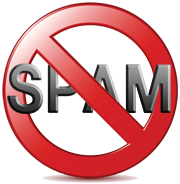Keeping Spam off your WordPress site/blog
 This is part 1 of a 2 part post.
This is part 1 of a 2 part post.
If you’re hosting a WordPress site/blog, chances are, you’re going to have to deal with spam comments being posted to your site. WordPress is the most popular CMS (Content Management System) environment in use by developers, with over 25% of websites globally now running WordPress. While it’s undeniably a powerful and flexible platform with which to build your site, it’s also the number 1 targeted platform for spammers.
Can’t I Just Ignore Spam?
Some people new to hosting sites will leave spam comments on their websites, thinking the appearance of comments & ping backs will look like their website is getting increased traffic and interest. Reasons you don’t want to do this include:
- Bad links will hurt your search engine placement. Google and other search engines are cracking down on bad links. If your site is linking to known unrepeatable sources, you will likely see your SEO rankings decline.
- Spam on your website tells your visitors you’re not paying attention to your website. Generally visitors to your site will see spam comments for what they are. This essentially tells your site visitors that you’re not keeping up with the management of your site’s content.
- Spam will slow down your website. Spam creates unnecessary additional content for your website to load, and can grow quite quickly if not managed. This will add time for every page to load on your website, and encourages visitors to abandon the page load and go elsewhere.
- Most Spam comments and trackbacks contain links. More bad news for your site’s visitors. Many of these links go back to virus/malware, which if followed, could lead to your visitor’s computer becoming infected, and possibly their computer/email account becoming compromised.
Now that you understand why it’s important to keep up maintenance of your website and keep comments & ping backs free from spam, let’s look at some approaches to help you accomplish this.
Automatically Filter Spam Using an Anti-Spam Plugin
By default, the anti-spam filter Akismet is installed and waiting for you to activate it. To do so, simply log into your WordPress dashboard, click on Plugins, and activate for Akismet. You will need to register with them to get the plugin running. Akismet will trap spam and notify you by email when new comments are awaiting moderation.
Regularly Check and Approve/Decline Comments
A continuation of the first point, Akismet will trap comments posted to your site, and allow you to Approve, Trash, or mark comments as Spam. Letting Akismet know a comment is spam also will help train its filter. No spam filter is perfect, so sometimes Akismet will place a legitimate comment or pingback into the spam folder. You should not just delete everything thats been tagged as spam, but go through to make sure legitimate comments get approved.
Disable Comments After a Period of Time
If you’re writing posts to your site, consider disabling comments to the posts after real comment traffic has settled down. What this period will be will depend on your site and how active comments are given a post you’ve put up.
More coming next week.
We’ll post part two of this next week. Until then….
Tags: advanced hosting, Combat Spam, fighting spam